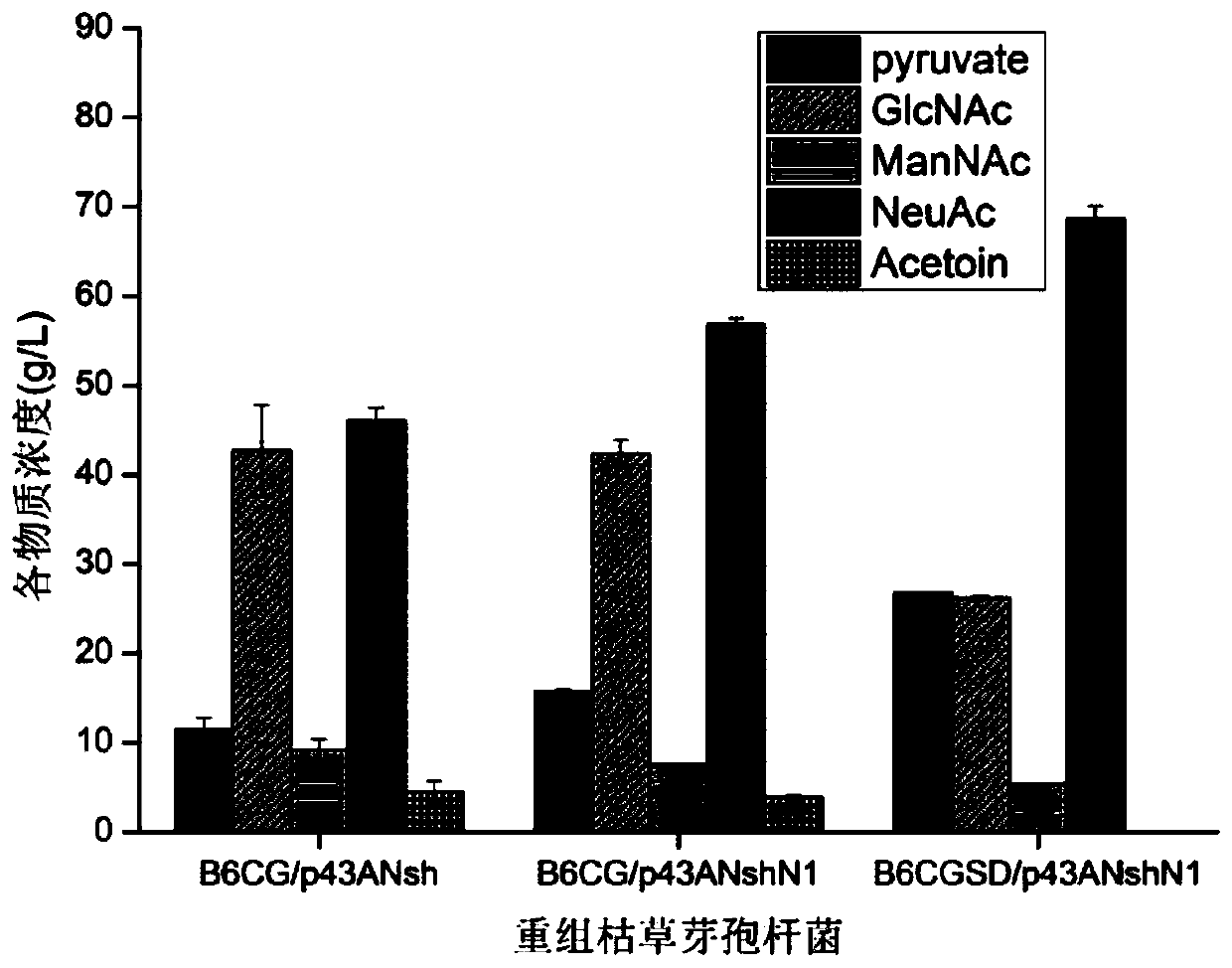Recombinant bacterium capable of using whole-cell transformation method to produce N-acetylneuraminic acid in high-yield manner and application
A technology of acetylneuraminic acid and whole cell transformation, applied in the field of genetic engineering, can solve the problems of low N-acetylneuraminic acid production and N-acetylglucosamine conversion rate, insufficient expression of key enzyme genes, etc., and achieve the effect of strengthening expression
- Summary
- Abstract
- Description
- Claims
- Application Information
AI Technical Summary
Problems solved by technology
Method used
Image
Examples
Embodiment 1
[0037] Example 1 Construction of recombinant plasmids with different expression strengths of ShNanA
[0038] According to the N-acetylglucosamine isomerase gene (age) synthetic gene in Anabaena sp.CH1 (GenBank: DQ661858.1) published on NCBI, the primers were designed:
[0039] AGE-F: 5’-TAATCTGTAACTCGAGAAAGGAGGAAGGATCAATGGGCAA-3’,
[0040] AGE-R: 5’-ACGTAGGTGGTGTGGCCCGGGTTATGAAAGTGCTTCAAAC-3’,
[0041] Using the above primers, the synthesized N-acetylglucosamine isomerase gene is used as a template to amplify the age gene fragment.
[0042] According to the N-acetylneuraminic acid aldolase gene (shnanA) of Staphylococcus hominis published on NCBI, the gene was synthesized, and the primers were designed: Shnal-F:5'-TATAAAGTGATAGCGGTACCATTATAGGTAAGAGAGGAATGTACACTCTAGAATGGAAGA ACAGCTGAAA-3',Shnal-R :5'-CCATTGATCCTTCCTCCTTTCTCGAGTTACAGATTATATGTTTCAATCAGCTGG-3',
[0043] Using the above primers, the synthetic N-acetylneuraminic acid aldolase (ShNanA) gene was used as a template to amplify sh...
Embodiment 2
[0045] Example 2 Construction of recombinant Bacillus subtilis with different expression intensities of ShNanA
[0046] The constructed p43ANsh and p43ANshN1 plasmids were transformed into Bacillus subtilis B6CG. The AGE-F and AGE-R primers designed in Example 1 were used to select transformants for colony PCR. After gel electrophoresis, a 1167bp band appeared, which verified the recombinant Bacillus subtilis spores. Bacillus B6CG / p43ANsh and B6CG / p43ANshN1 were successfully constructed.
Embodiment 3
[0047] Example 3 Construction of Recombinant Bacillus Subtilis Blocking Acetoin Production
[0048] 1) Construction of recombinant fragments
[0049] Using the Bacillus subtilis B6CG genome as a template, the upstream primer AlsSDL-F: 5'-GCAAGTATTGTTCATGTACCTGCATCACTCTCTT-3' and the downstream primer AlsSDL-R: 5'-ACTCCTTATTATGCATTTTAAACGTAA-3' were used to amplify the upstream of the genes to be knocked out alsS and alsD Recombinate the homologous left arm fragment, and use the Bacillus subtilis B6CG genome as the template to use the upstream primer AlsSDR-F: 5'-AGAAAGCCCCTTTTAGCAGGG-3', and the downstream primer AlsSDR-R: 5'-CCCTACTGCGCTGTCAGAAGCAAAATCAG-3' to amplify the same Source recombinant right arm fragment. Use plasmid P7z6 as template to pass upstream primers
[0050] P7z6-F: 5'-TAAAATGCATAATAAGGAGTCTCGCCTATTGTTAAAGTGTGTCCTT-3', and the downstream primer P7z6-R: 5'-GCCCTGCTAAAAGGGGCTTTCTATTGCGGTCCCAAAAGGGTCAGTGC-3', amplify the zeocin resistance gene containing lox72 and ...
PUM
 Login to View More
Login to View More Abstract
Description
Claims
Application Information
 Login to View More
Login to View More - R&D
- Intellectual Property
- Life Sciences
- Materials
- Tech Scout
- Unparalleled Data Quality
- Higher Quality Content
- 60% Fewer Hallucinations
Browse by: Latest US Patents, China's latest patents, Technical Efficacy Thesaurus, Application Domain, Technology Topic, Popular Technical Reports.
© 2025 PatSnap. All rights reserved.Legal|Privacy policy|Modern Slavery Act Transparency Statement|Sitemap|About US| Contact US: help@patsnap.com


